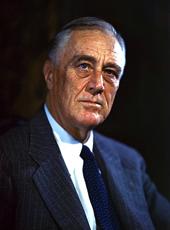THE PRESIDENT: Yesterday, at the Council meeting, the Secretary of Labor reported that—and for the long-faced gentry throughout the country this will come as a terrible shock—a survey of industrial disputes, made on a basis of comparisons with the last previous comparable period, 1921, when we were beginning to snap back out of the post-war depression, shows that in the six summer months of 1921 there were 1,453 strikes and lock-outs, and in 1933 there were 900. In the 1921 period 895,000 employees were involved in those strikes and lockouts. In the same period this year 584,000 were involved. The Secretary of Labor said that this indicates, of course, that there is no need for the public to become in the least bit alarmed over present disputes. On the basis of man hours, the number of actual working hours involved, the comparison is even more favorable because, of course, in 1921 the average day's work was a great deal higher than it is today. . . .
Q. Did the figures you referred to, were they the same that Miss Perkins gave out about a week ago?
THE PRESIDENT; I don't know; she brought them in to the meeting.
Q. The Annalist, in commenting, said that the figures of the Labor Department, while they are correct, failed to show that the strikes were rapidly rising in number in 1933, during the last three months, while they were decreasing in 1921 and that the number in 1933, during the last few months, was really larger than the number in 1921.
THE PRESIDENT: Well, let's give the other side in order to make it fair. That statement of the Annalist may be perfectly true, but, on the other hand, this year there were a great many strikes that were called for what might be called "test purposes," in order to get an immediate entrance of the National Labor Board into the situation. They were what might almost be called "friendly strikes." To give you an example, take the strike two months ago by one of the garment unions in New York City. That strike, you might almost say, was called by agreement between the decent employers and the Union in order to lay down certain rules and create an agreement to eliminate the sweatshop conditions in New York City.
Now, I suppose that the Annalist might figure that that was a very, very large strike affecting 40,000 people. I don't know that the word "strike" really applies to that kind of cessation of work. It is done with a distinct objective, agreed to by the employers and the employees. Is it a strike? I raise that question.
Then there is another thing which must be remembered always. In periods of rising prosperity and greater employment you always have an increase in the number of strikes. That is due to the very obvious human reason that an individual who is employed when unemployment is rising doesn't strike if he can possibly help it because if he strikes and fails he has no chance to get a job. He is thinking about the food for the family the next day. Therefore it is a pretty encouraging thing to see people who have the guts to stand up for their own rights; and it means that they feel that they can get employment somewhere else if they are thrown out ....
Franklin D. Roosevelt, Press Conference Online by Gerhard Peters and John T. Woolley, The American Presidency Project https://www.presidency.ucsb.edu/node/207779

